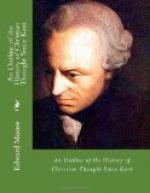Kant used the word ‘critique’ so often that his philosophy has been called the ‘critical philosophy.’ The word therefore needs an explanation. Kant himself distinguished two types of philosophy, which he called the dogmatic and critical types. The essence of a dogmatic philosophy is that it makes belief to rest upon knowledge. Its endeavour is to demonstrate that which is believed. It brings out as its foil the characteristically sceptical philosophy. This esteems that the proofs advanced in the interest of belief are inadequate. The belief itself is therefore an illusion. The essence of a critical philosophy, on the other hand, consists in this, that it makes a distinction between the functions of knowing and believing. It distinguishes between the perception of that which is in accordance with natural law and the understanding of the moral meaning of things.[3] Kant thus uses his word critique in accordance with the strict etymological meaning of the root. He seeks to make a clear separation between the provinces of belief and knowledge, and thus to find an adjustment of their claims. Of an object of belief we may indeed say that we know it. Yet we must make clear to ourselves that we know it in a different sense from that in which we know physical fact. Faith, since it does not spring from the pure reason, cannot indeed, as the old dogmatisms, both philosophical and theological, have united in asserting, be demonstrated by the reason. Equally it cannot, as scepticism has declared, be overthrown by the pure reason.
The ancient positive dogmatism had been the idealistic philosophy of Plato and Aristotle. The old negative dogmatism had been the materialism of the Epicureans. To Plato the world was the realisation of ideas. Ideas, spiritual entities, were the counterparts and necessary antecedents of the natural objects and actual facts of life. To the Epicureans, on the other hand, there are only material bodies and natural laws. There are no ideas or purposes. In the footsteps of the former moved all the scholastics of the Middle Age, and again, even Locke and Leibnitz in their so-called ‘natural theology.’ In the footsteps of the latter moved the men who had made materialism and scepticism to be the dominant philosophy of France in the latter half of the eighteenth century. The aim of Kant was to resolve this age-long contradiction. Free, unprejudiced investigation of the facts and laws of the phenomenal world can never touch the foundations of faith. Natural science can lead in the knowledge only of the realm of the laws of things. It cannot give us the inner moral sense of those things. To speak of the purposes of nature as men had done was absurd. Natural theology, as men had talked of it, was impossible. What science can give is a knowledge of the facts about us in the world, of the growth of the cosmos, of the development of life, of the course of history, all viewed as necessary sequences of cause and effect.




